To say that smooth sumac (
Rhus glabra) is a common shrub is an understatement, as it is the only tree or shrub that naturally occurs in all of the lower 48 U.S. states. During most of the year it is easily overlooked as just another leafy plant, but in the fall it, and its close relatives staghorn and flameleaf sumac (
R. typhina and
R. copallina,
respectively), turn from cool green to intense shades ranging from yellow to scarlet to purple.

Missouri Botanical Garden
These sumacs are not for every garden. They are aggressive, with wide-spreading, shallow root systems, and are best matched up with other strong plants that can hold their own.
Botanical name: Rhus glabraCommon names: Smooth sumac, red sumac, upland sumac, vinegar tree
Origin: Can be found growing naturally in nearly every U.S. state; most commonly found east of the Mississippi River
Where it will grow: Hardy to minus 40 degrees Fahrenheit, or minus 40 degrees Celsius (USDA zones 3 to 9; find your zone)
Typical plant communities: Fence rows, woodland edges, savannas, prairies and roadsides; as a pioneer plant, does well on recently disturbed sites
Shown: A fully formed fruit cluster in late summer; these berries will remain on the plant well into winter
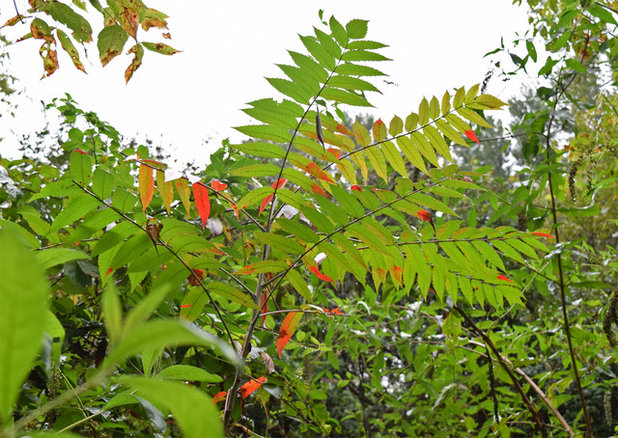 Water requirement:
Water requirement: Low; prefers average to dry soil
Light requirement: Full sun; tolerates only a little shade
Mature size: 8 to 15 feet tall and wide; plants often form colonies from root suckers, radiating out from a single parent plant
Shown: A 2- to 3-year-old plant poking out above the surrounding shrubs. This photo was taken in early October as the fall color was beginning to develop.
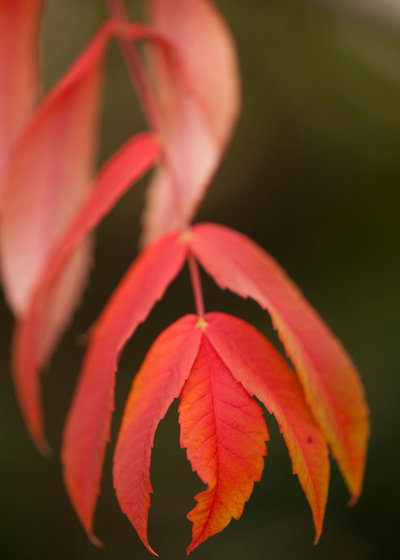
The New York Botanical Garden
Benefits and tolerances: Grows in disturbed sites; tolerates poor, thin soils and somewhat tolerates saline and alkaline soils; spreading, shallow roots stabilize slopes against erosion
Seasonal interest: Dark green, frond-like leaves transform to orange to deep red and purple in fall; female plants produce dense spikes of scarlet-colored berries in late summer that remain intact until late in the winter, when birds are less picky about what they eat.
When to plant: Container plants can be planted in the spring or fall.
Shown: Foliage at peak fall color
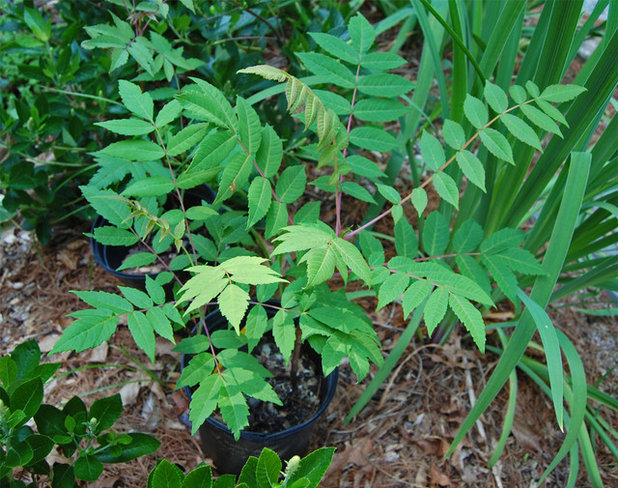
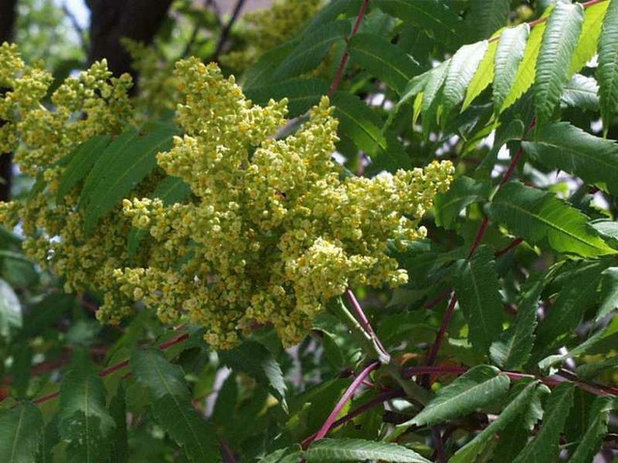
Missouri Botanical Garden
Distinguishing traits. The leaves are long and pinnately compound, with nine to 27 leaflets each. The central stem of the leaf has a reddish cast. The leaflets are dark green on the top with a whitish bloom on the bottom sides. Each leaflet is coarsely toothed. The stems and buds are smooth, often with a whitish or bluish bloom. Smooth sumac is most noticeable in autumn, when its leaves transform to intense shades of orange, scarlet and purple.
The plants are single-sexed (dioecious), either male or female. The flowers, appearing in June and July, are green and do not really stand out, but they attract a wide variety of bees, wasps and butterflies. The male flowers are larger and produce both nectar and pollen. The smaller female flowers produce only nectar to attract pollinators. Female flowers that have been pollinated will go on to produce dense scarlet fruiting clusters that last well into winter.
Shown: A cluster of the green male flowers
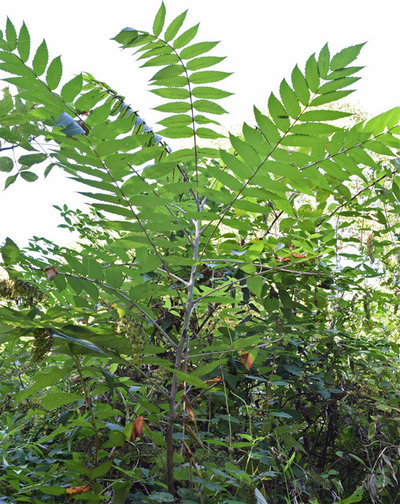 How to use it.
How to use it. Smooth sumac, like other members of the genus, is an aggressive, colony-forming shrub. If used in a formal setting it needs to be managed to control its spread. For instance, it could be grown in a large pot so that you could experience its unique foliage and fall color without its taking over the garden. There is a cultivar with finely dissected foliage called
R. glabra ‘Laciniata’ that would work well for this.
It is best used in a naturalistic garden, on a difficult slope, on the edge of a woodland or in a hedgerow. Mass plantings are very effective, especially viewed at a distance. Used with other aggressive growers, it can hold its own. It is intolerant of shade, so it should not encroach into a woodland shade garden.
Because of its shade intolerance, the lower branches tend to fall off, leaving naked stems below. This can be used to advantage, by filling the space underneath with medium-sized grasses and low shrubs. Some common native associates include eastern redcedar (
Juniperus virginiana), New Jersey tea (
Ceanothus americanus), gray dogwood (
Cornus racemosa) and prairie rose (
Rosa setigera).
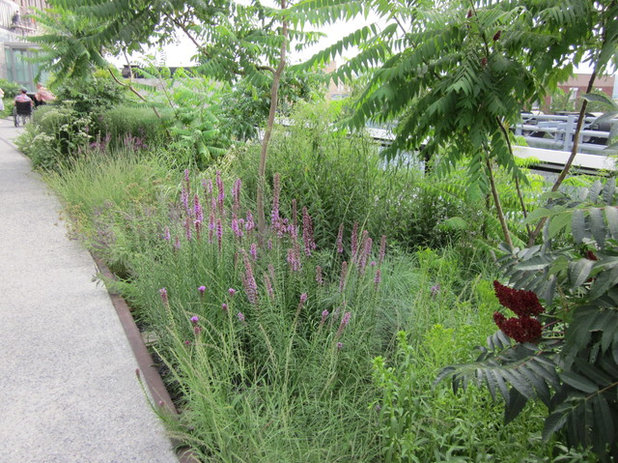
Here’s smooth sumac planted in the High Line, in New York City. Other plants shown here include dense blazingstar (
Liatris spicata) and lead plant (
Amorpha canescens).
Photo by sharon_k
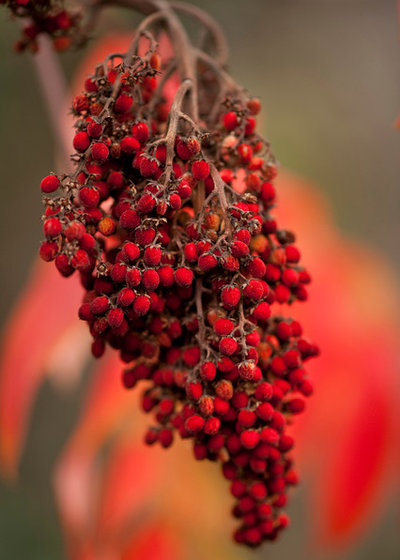
The New York Botanical Garden
The tight clusters of sumac berries also add interest to the garden in the winter. These berries last late into winter and provide food for overwintering species of birds. The ripe berries have an acidic taste and can be soaked in water to make something similar to lemonade. (Older berries with no fuzz have lost their acidic flavor.)
In addition to providing pollen and nectar for native bees and late-season food for birds, smooth sumac is a larval host for the hairstreak butterfly.
Planting notes. I have had good success planting bare-root plants in the spring. Growth is rapid, with plants doubling or tripling in size during their first full season. While aggressive, colonies can lose their vigor after about 15 years. Plants may be reinvigorated by cutting them to the ground in midwinter.
Due to their clonal nature, masses seen in the wild are often single-sexed, all males or all females. If you don’t have some of these colonies already in the area, you should plant several individuals to increase the odds for having at least one of each sex. Otherwise, berry production will not occur. It takes three to four years for a seedling to begin producing flowers.
In my garden, deer show a preference for smooth sumac, eating the leaves and ends of the twigs. Surrounding the plants with a chicken wire barrier helps smaller plants get established.
Smooth sumac may be difficult to find at a retail nursery, but several mail order nurseries sell it. You should also check with local native-plant nurseries. Since this species is spread across the U.S., individual plants have adapted to a wide range of local conditions. It would be best to find plants that came from a habitat or climate similar to your area’s.





